As the lust and passion for minting quick money grew, original Pashmina shawls began to be replaced with cheap and forfeited quality ones. Hence came the GI Pashmina. It was the purest quality Pashmina shawl, engraved with a stamp of originality and authentication. This helped customers pick the right product, and discard the imitations.
The iconic rendezvous between fine wool and skilful techniques of Kashmiri artisans started centuries ago. It was around the 15th century when handcrafting luxury items from raw wool raised the standards of the locals; they became overnight celebrities. This wool was native to Kashmir, as was its processing. No other country could neither produce wool of such a thin diameter nor process any wool type to make apparel and wraps of such finesse. It was Kashmir that got into exporting its produce. This made Kashmir the talk of the town, all over the world. This wool was Cashmere. Cashmere was processed to make Pashmina shawls.
What is Pashmina?
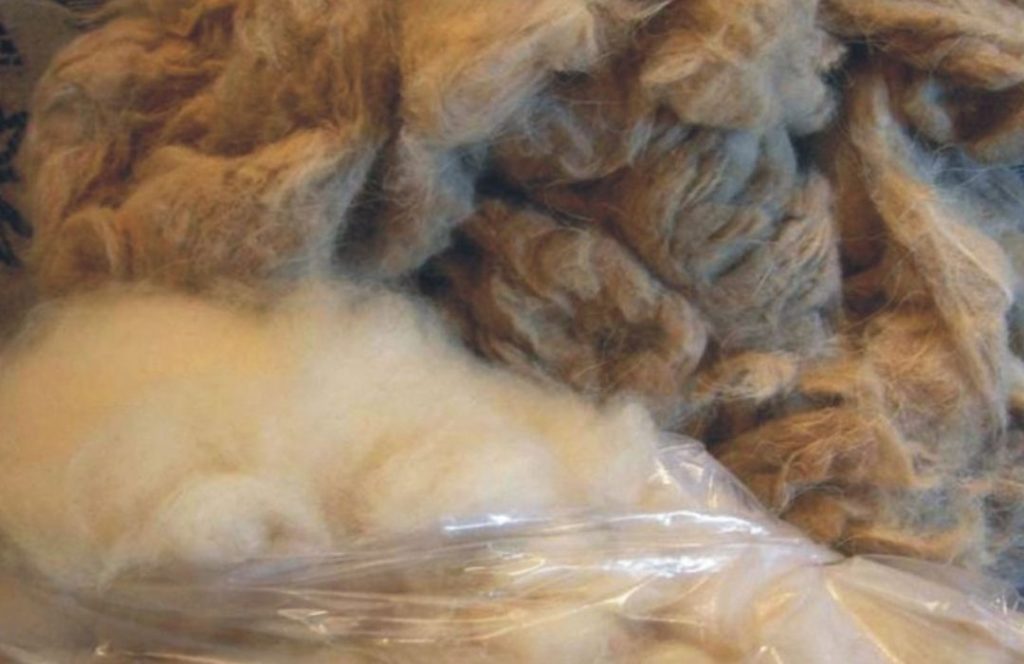
Pashmina is the art of handcrafting luxury apparel, wraps and accessories from fine Cashmere. The wool grows on the body of a rare goat, which is found in the Himalayan ranges. Its manual acquisition, cleaning, processing transforms it into the most luxuruous and precious shawls in the world.
It is Pashmina shawls which originated in the 15th century, changing the face of the valley once and for all. The same people, never known to anyone, became the most celebrated artisans. Patrons from all around the world came to see them.
Pashmina or Cashmere?
Pashmina comes from the Persian word ‘Pashm’, which literally translates to ‘soft gold’. This was the term used to describe the utmostly soft wool which came from the goat. Since the discovery the wool came from a Persian traveller, he used the beauty of his own language to describe the same. Hence the raw wool acquired from the Himalayas was called Pashm. Products handcrafted from Pashm wool are called Pashmina. Artisans crafted Pashmina shawls, Pashmina scarves, Pashmina socks, Pashmina blankets, Pashmina furnishing and upholstery and more.
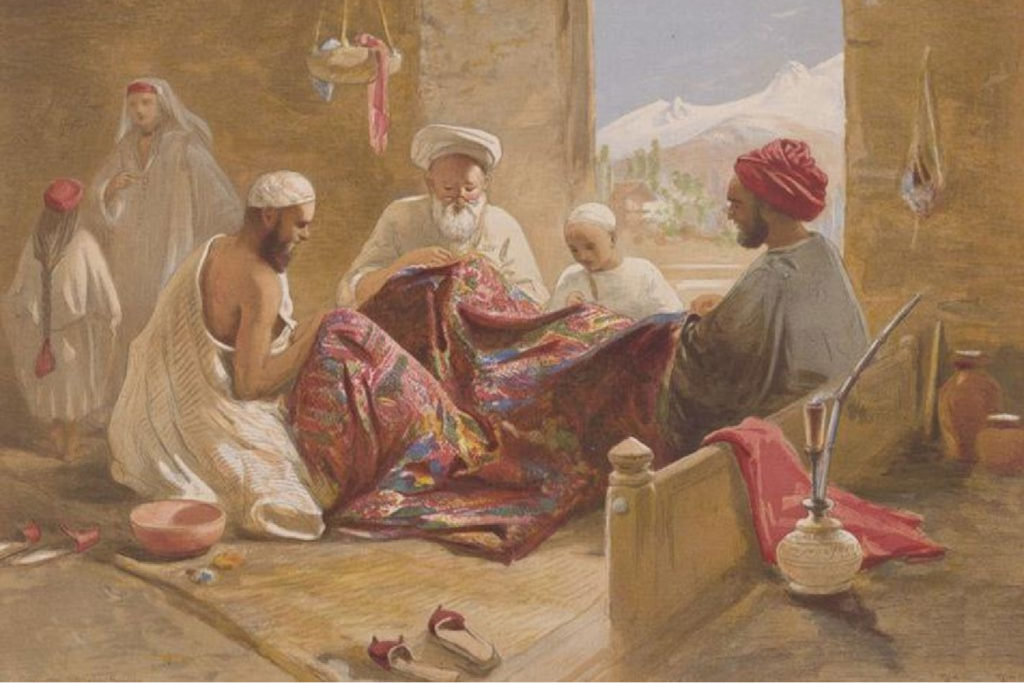
In the 18th century, products made from fine Pashm came to the notice of Europeans, and the world at large. These foreign patrons visited the valley in large groups to have a look at this newly discovered Pashmina. They, however, didn't call it Pashmina, but Cashmere (Cashmere being an anglicization of the term Kashmir). Hence Cashmere was, now, the raw wool acquired from the goat. And Pashmina was the art of transforming Cashmere into luxury wraps and apparel.
There are sources which claim that the difference between Pashmina and Cashmere is the composition. Some argue that Pashmina is a finer version of Cashmere. This is not true. Cashmere is the fine and soft wool. It is cleaned after acquiring it from the goat which grows it. Pashmina is an art, indigenous to the Kashmir valley, which means handcrafting luxury shawls, wraps and apparel from Cashmere wool.
Cashmere and The Himalayas
The goat which grows Cashmere on its body has a number of locations in different parts of the Himalayan ranges. As such, Cashmere is found in India (Ladakh), Nepal, China, Mongolia, Iran, Afghanistan, and Pakistan. India accounts for just 1% of the total Cashmere production in the world.
Acquisition of Cashmere
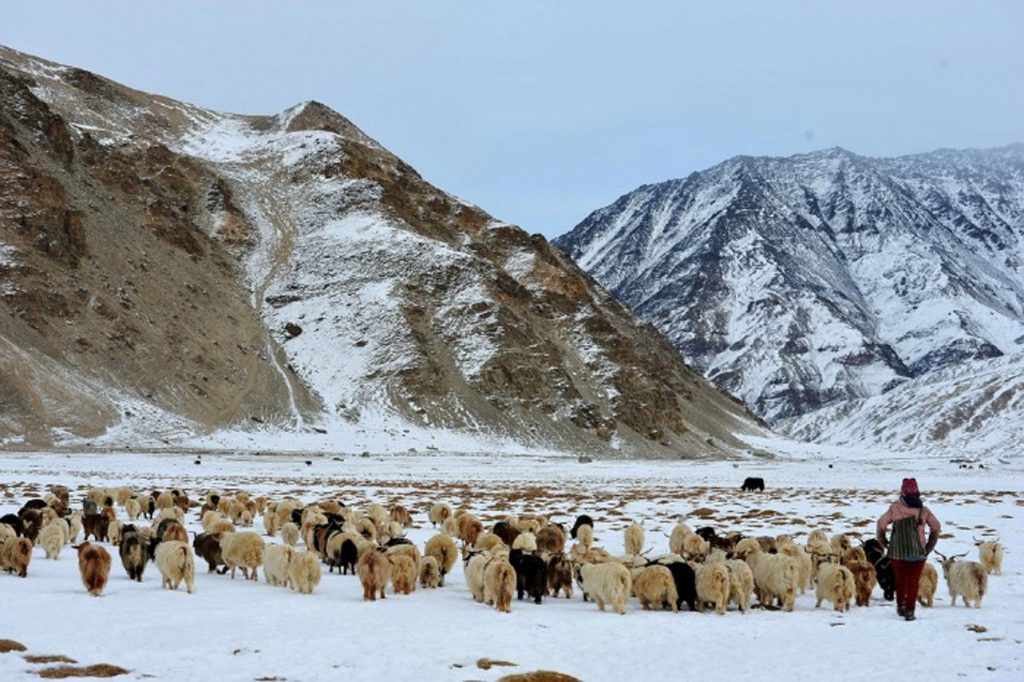
As mentioned earlier, the least of the world Cashmere production is produced in North India. However, it is the best and the finest quality Cashmere. This Cashmere is from Ladakh, North India, the home to the Changthangi goat. This goat lives on the Changthang plateau of Ladakh. It is situated over 14000 feet above sea level. This plateau is home to Buddhist tribes. The tribe's primary responsibility is to rare sheep and goats. The Cashmere bearing goat is one of their domesticated animals. These goats are locally called Changthangi goats, named after the place. They are also called Cashmere or Pashmina goats due to the growth of fine wool over their bodies.
The high plateaus of Changthang experience one of the most freezing temperatures in winter. At times, scales fall to -40 degrees C. For this reason, the locals as well as the animals make it a point to protect themselves. The Buddhist monks wear thick coats made from animal skins and fur, whereas the animals have their own protection. The Changthangi goat, too, grows fine wool as an undercoat. The wool is so warm and comfortable that the entire winter, it saves the goat from dying or even a single episode of discomfort. This fine and warm wool grow on its underbelly, neck, behind ears, and other sensitive parts of its body. This is Cashmere.
Collection of Cashmere
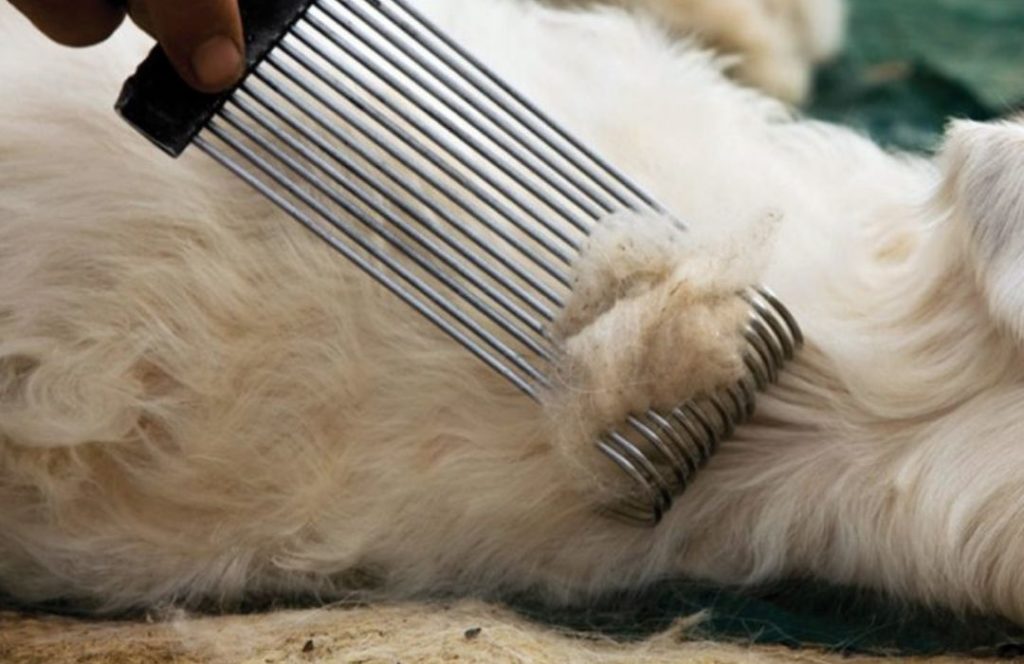
As soon as winter is over, Spring starts. The Cashmere goat starts experiencing several hormonal changes in its body, and the wool starts falling off. Next, as Summer steps in, the goat loses more hair, much of it by rubbing itself against coarse surfaces. Summers are pretty warm in the area, and hence make the goat uncomfortable with the warm wool on its body. Hence it rubs its body against walls, stones, bushes and other nearby areas, losing most of the hair. Some portion left is combed gently off its body by professionals, who use specialized tools and combs to do so. Note that the goats are not hurt or killed during the process and the entire combing is safe and secure.
Now the goat is free to roam around. This hair grows back as soon as winter is about to begin. Animals do not freeze to death, as claimed by a number of reporters. The falling off and growing back of Cashmere from the body of a Changthangi goat are natural processes
The acquired Cashmere wool from the goats is cleaned first. It is full of waste, dirt, dust, and every contamination that the animals pass through. It is hence cleaned thoroughly by womenfolk and even men of the valley, before packing it into small packets. These packets are sent to Kashmir where processing begins and ends. Even though Ladakh has the world's best quality Cashmere, they lack the proper infrastructure for processing it. Artisans responsible for processing Cashmere are only present in Kashmir.
Processing of Cashmere
Processing of Cashmere starts once it reaches the valley of Kashmir. The packets are opened and fine wool is again washed thoroughly to get rid of any foreign material. Post-cleaning, the wool is dipped in a thick rice powder paste. By doing so, Cashmere wool gains strength and smoothness. It is removed after three days, washed again, and now set for spinning.
Spinning Cashmere is done primarily by the womenfolk of a family. Since making Pashmina shawls is a family affair, different processes are handed over to different members. Womenfolk mount the lumps of threads onto spinning wheels and transform these into the long and fine fibre. The fibre is just 12 to 16 microns and is extremely difficult to handle and manage. It is just the skill and decades-long experience of these women which allows them to work with this wool-like breeze.
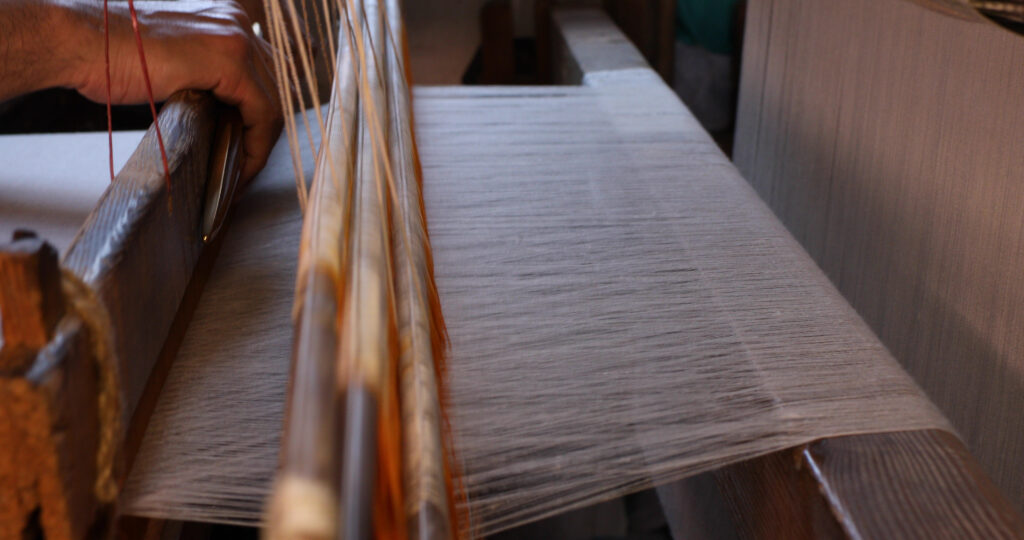
Post-spinning, the fine threads of spun Cashmere are sent to weaving. Men await the fibres, and mount these onto the handloom once received. Two or three men sit alongside the handloom and in 3 to 4 days complete a Pashmina shawl. Fibres of Cashmere get transformed into the fabric. This is the birth of a plain shawl. It is later embroidered, patterned, printed, laced or embellished in whatever design the customer likes.
Fake Pashmina Shawls
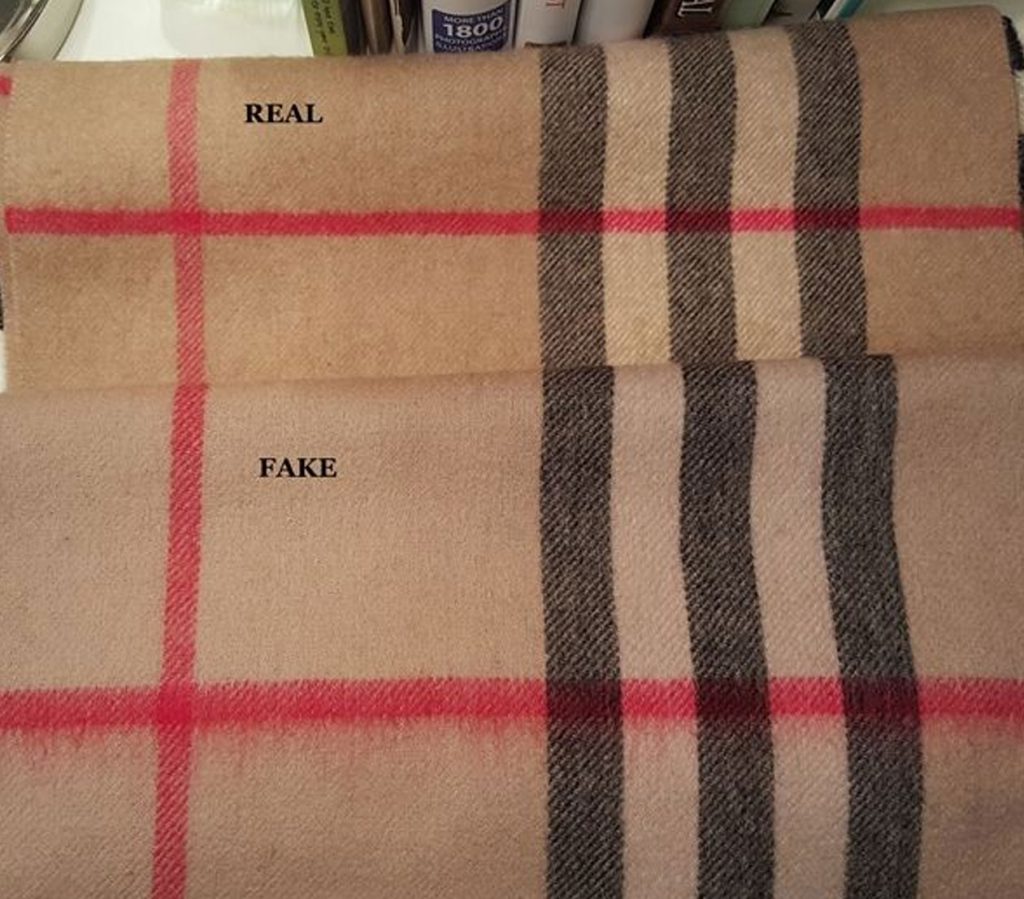
As soon as the sales of Pashmina shawls gained impetus, the craftsmen community became one of the richest communities in society. These people were offered foreign tours, where they would be asked to train locals. This fame and affluence were craved by many individuals, who out of greed introduced fake shawls into the market. Fake Pashmina shawls were those which were made by machines. To bear the strain of the machine, pure Cashmere fibre is mixed with silk or nylon, which helps it endure the stress that the machine causes. These shawls were circulated in the markets by several fraudulent and deceitful traders and hence sold to those who wanted pure pieces.
While pure Pashmina shawls remained for a lifetime, these fake shawls couldn’t last 3 years even and withered soon. This caused an uproar and the prestige of the Pashmina industry was whittled away. This led to fewer sales and hence a demoralized artisan community, whose art now lay waste.
Also read: PASHMINA FOR THE POSITIVELY CONSCIOUS - AN ETHICAL STORY
The Geographical Indication - an Initiative to restore the glory of Pashmina shawls
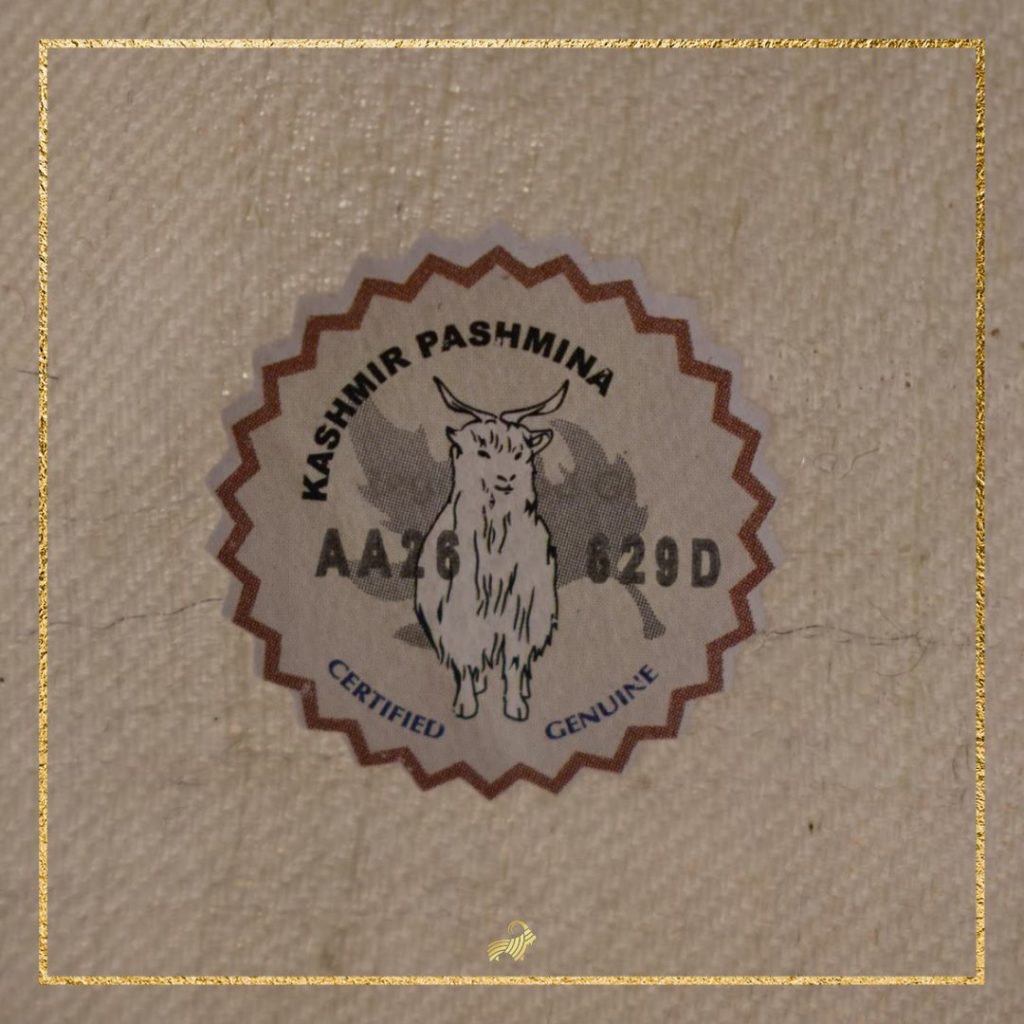
Kashmir Pashmina has been bestowed the Geographical Indicator (GI) in 2008. GI is the stamp used on products that have a particular geographical origin and possess qualities which are there because of that origin. Hence the qualities which qualify a product for GI depend upon the geographic location of its production. A GI mark helps one to protect the product’s use by any third party whose production does not conform to the set standards.
Kashmiri Pashmina shawl has its roots and origin in Kashmir. Here artisans use age-old techniques and unique processes to handcraft the Pashmina shawl. Hence Kashmiri Pashmina has been registered under the Geographical Indication registration of India.
To identify genuine, original Pashmina shawls, a label has been developed by the Craft Development Institute (CDI) Srinagar. This is the GI label, used for authentication of handspun and handwoven Pashmina. This label is non-imitable and contains a numeric code which can be checked online on their website. If the code matches the one on the website, your shawl is pure.
Also read: EMPOWERING PASHMINA ARTISANS
Aim of introducing GI label for Pashmina
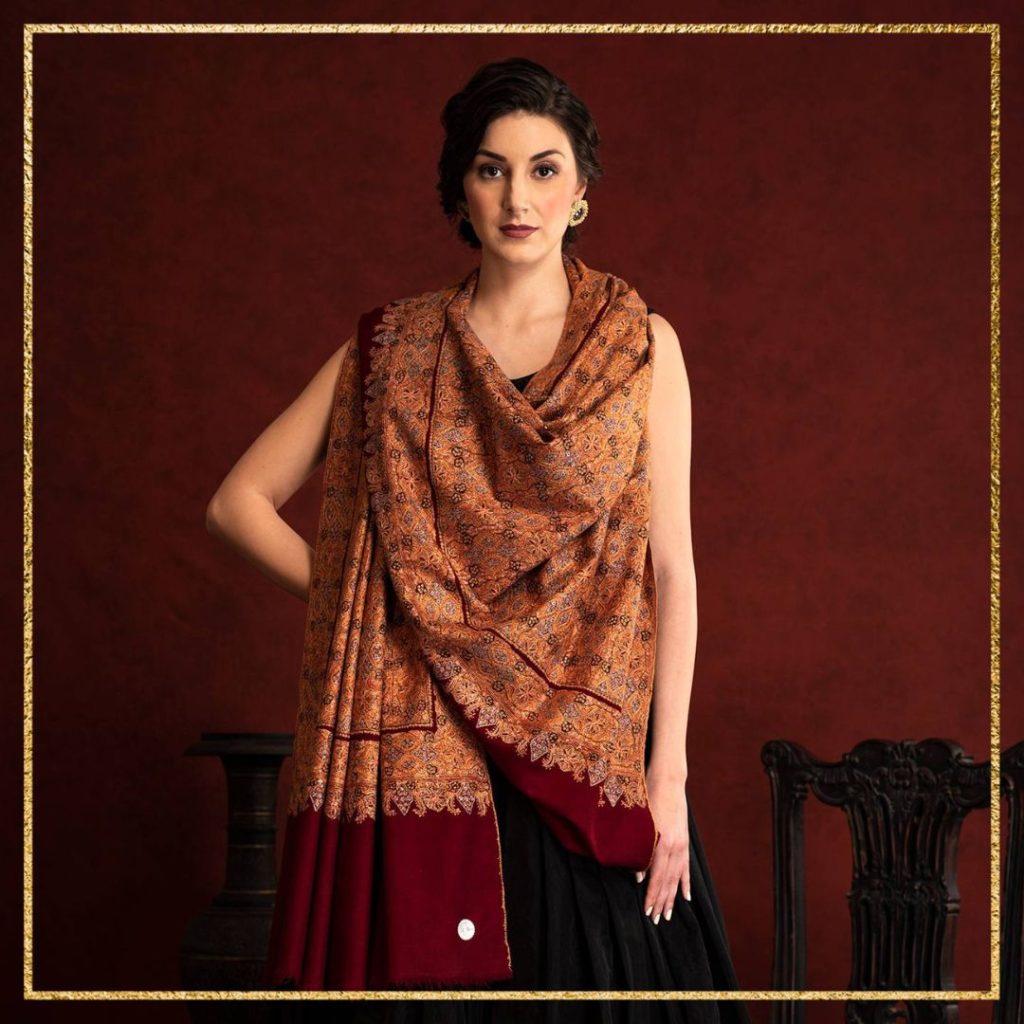
GI label came into being with an initiative from the Government of India. The main reason for the introduction of the GI label was to save the lost glory of Kashmiri Pashmina. Here are other reasons for introducing the GI tag:
- To specify original and pure Pashmina Shawls and save customers from being cheated with fake ones
- Protect the livelihood of artisans, who lost their jobs and sustenance because of the machines.
- Sustain and protect local handicrafts, and hence help in flourishing the economy.
Testing for GI is done by the PTQCC department of Craft Development Institute. PTQCC is the Pashmina Testing and Quality Certification Centre, and is a lab managed by the Government of India. Labelling is done in batches, after properly testing shawls one by one. The shawls go through quality control checks using electronic microscopy, and physical and chemical tests before stamping them. The stamp, which is found around one of the corners of the shawl, is patented. One can see 100% Genuine and Registered Pashmina under UV light and green sparkling under laser light.
Testing Pashmina Shawls for GI
For passing the test to qualify for a GI tag, a Pashmina shawl should have the following features.
- It should be obtained from Ladakh, and the diameter of the Cashmere fibre used in it should be less than 16 microns
- The shawl should be handspun, and spinning should be done over the traditional Charkha called ‘Yinder’.
- The shawl should be handwoven on a wooden traditional handloom.
Benefits of GI in Kashmir Pashmina
- Increase in turnover and exports: Since the Geographical Indication was introduced, patrons came back to reach for their favourite art form.
- Premium price for products: Fake products were cheap. Since the introduction of GI, Pashmina began to demand its own deserving price
- Better wages to artisans: Artisans are getting empowered since the pieces they thought were waste are again in great demand.
- Differentiation from fake and imitated goods: The originality of genuine Pashmina shawl came to light, and the GI stamp differentiated purely from fake
- Brand Identity: The GI stamp made Kashmiri Pashmina a brand. It is now easily recognizable among locals and foreigners.
- Conservation of heritage: Preserving the glory and heritage of this unique art was essential. With the introduction of the GI stamp, now pure Pashmina is identifiable, and hence the legacy is conserved.
The Geographical Indication is still new to the people of Kashmir and the world. Awareness still needs to be raised about the benefits of GI stamps, and people need to know why a pure Pashmina needs more investment than a fake piece or a machine-made shawl. The promotion of genuine Kashmiri Pashmina is still a challenge, yet fundamental.
Also read: PURE PASHMINA - MYTHS AND FACTS